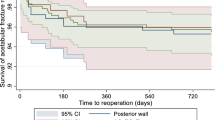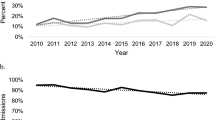Abstract
Introduction
The World Health Organization (WHO) postulates that depressive disorders (DD) will be the leading cause of morbidity and mortality by 2030. Studies evaluating the association of DD following open reduction and internal fixation (ORIF) for the treatment of acetabular fractures are limited. Therefore, the purpose of this matched-control study was to determine whether DD patients undergoing ORIF for acetabular fractures have higher rates of: (1) in-hospital lengths of stay (LOS); (2) readmissions; (3) medical complications; and (4) costs of care.
Materials and methods
A retrospective query from the 100% Medicare Standard Analytical Files (SAF) was performed to identify patients who underwent ORIF for acetabular fractures. The study group consisted of those patients with DD, whereas patients without the condition served as controls. Primary endpoints of the study were to compare in-hospital LOS, readmission rates, ninety-day medical complications, and costs of care. A p-value less than 0.01 was considered statistically significant.
Results
The query yielded 7084 patients within the study (ORIF = 1187, control = 5897). DD patients were found to have significantly longer in-hospital LOS (11 days vs. 10 days, p < 0.0001); however, odds (OR) of readmission rates were similar (23.16 vs. 18.68%; OR: 0.91, p = 0.26). Multivariate regression demonstrated DD to be associated with significantly higher (67.69 vs. 25.54%; OR: 2.64, p < 0.0001) 90-day medical complications. DD patients had significantly higher day of surgery ($30,505.93 vs. $28,424.85, p < 0.0001) and total global 90-day costs ($41,721.98 vs. $37,330.16, p < 0.0001) of care.
Conclusion
After adjusting for covariates, DD is associated with longer in-hospital, complications, and costs of care in patients undergoing ORIF for the treatment of acetabular fractures, whereas readmission rates are similar. The study is vital as it can be used by orthopaedists and healthcare professionals to adequately educate these patients of the potential outcomes following their surgical procedure.

Similar content being viewed by others
References
Malhi GS, Mann JJ (2018) Depression. Lancet (London, England) 392(10161):2299–2312. https://doi.org/10.1016/S0140-6736(18)31948-2
Tolentino JC, Schmidt SL (2018) DSM-5 criteria and depression severity: implications for clinical practice. Front psychiatry 9:450. https://doi.org/10.3389/fpsyt.2018.00450
Uher R, Payne JL, Pavlova B, Perlis RH (2014) Major depressive disorder in DSM-5: implications for clinical practice and research of changes from DSM-IV. Depress Anxiety 31(6):459–471. https://doi.org/10.1002/da.22217
Lim GY, Tam WW, Lu Y, Ho CS, Zhang MW, Ho RC (2018) Prevalence of depression in the community from 30 countries between 1994 and 2014. Sci Rep 8(1):2861. https://doi.org/10.1038/s41598-018-21243-x
Swiggett SJ, Vakharia AM, Ehiorobo JO, et al (2021) Impact of depressive disorders on primary total shoulder arthroplasties: a matched control analysis of 113,648 Medicare patients. Shoulder Elb. Published online April 19, 2020:175857322091684. doi:https://doi.org/10.1177/1758573220916846
Vakharia RM, Ehiorobo JO, Sodhi N, Swiggett SJ, Mont MA, Roche MW (2020) Effects of depressive disorders on patients undergoing primary total knee arthroplasty: a matched-control analysis. J Arthroplasty 35(5):1247–1251. https://doi.org/10.1016/j.arth.2019.12.011
Haupt E, Vincent HK, Harris A et al (2018) Pre-injury depression and anxiety in patients with orthopedic trauma and their treatment. Injury 49(6):1079–1084. https://doi.org/10.1016/j.injury.2018.03.024
Becher S, Smith M, Ziran B. Orthopaedic trauma patients and depression: A prospective cohort. In: Journal of Orthopaedic Trauma. Vol 28. Lippincott Williams and Wilkins; 2014:e242-e246. doi:https://doi.org/10.1097/BOT.0000000000000128
Mollon B, Mahure SA, Ding DY, Zuckerman JD, Kwon YW (2016) The influence of a history of clinical depression on peri-operative outcomes in elective total shoulder arthroplasty. Bone Jt J 98-B(6):818–824. https://doi.org/10.1302/0301-620X.98B6.37208
Crichlow RJ, Andres PL, Morrison SM, Haley SM, Vrahas MS (2006) Depression in orthopaedic trauma patients: prevalence and severity. J Bone Jt Surg Ser A 88(9):1927–1933. https://doi.org/10.2106/JBJS.D.02604
Fiest KM, Jette N, Quan H et al (2014) Systematic review and assessment of validated case definitions for depression in administrative data. BMC Psychiatry 14(1):289. https://doi.org/10.1186/s12888-014-0289-5
Sturmer T, Brenner H (2001) Degree of matching and gain in power and efficiency in case-control studies. Epidemiology 12(1):101–108. https://doi.org/10.1097/00001648-200101000-00017
Adeyemi A, Trueman P (2019) Economic burden of surgical site infections within the episode of care following joint replacement. J Orthop Surg Res. https://doi.org/10.1186/s13018-019-1224-8
Sabeh K, Rosas S, Buller L, Freiberg A, Emory C, Roche M (2014) The Impact of Medical Comorbidities on Primary Total Knee Arthroplasty Reimbursements. J Knee Surg. Published online May 23, 2018. doi:https://doi.org/10.1055/s-0038-1651529
Donnally CJ, Vakharia RM, Rush AJ et al (2019) Fibromyalgia as a predictor of increased postoperative complications, readmission rates, and hospital costs in patients undergoing posterior lumbar spine fusion. Spine (Phila Pa 1976) 44(4):E233–E238. https://doi.org/10.1097/BRS.0000000000002820
Gu A, Wei C, Maybee CM, Sobrio SA, Abdel MP, Sculco PK (2018) The impact of chronic obstructive pulmonary disease on postoperative outcomes in patients undergoing revision total knee arthroplasty. J Arthroplasty 33(9):2956–2960. https://doi.org/10.1016/j.arth.2018.05.009
Cancienne JM, Patel KJ, Browne JA, Werner BC (2018) Narcotic use and total knee arthroplasty. J Arthroplasty 33(1):113–118. https://doi.org/10.1016/j.arth.2017.08.006
Kurowicki J, Rosas S, Khlopas A et al (2018) Impact of perioperative HbA1c on reimbursements in diabetes mellitus patients undergoing total hip arthroplasty: a nationwide analysis. J Arthroplasty 33(7):2038–2042. https://doi.org/10.1016/j.arth.2018.01.062
Menendez ME, Neuhaus V, van Dijk CN, Ring D (2014) The elixhauser comorbidity method outperforms the charlson index in predicting inpatient death after orthopaedic surgery. Clin Orthop Relat Res 472(9):2878–2886. https://doi.org/10.1007/s11999-014-3686-7
Weinberg DS, Narayanan AS, Boden KA, Breslin MA, Vallier HA (2016) Psychiatric illness is common among patients with orthopaedic polytrauma and is linked with poor outcomes. J Bone Jt Surg Am 98(5):341–348. https://doi.org/10.2106/JBJS.15.00751
Nota SPFT, Bot AGJ, Ring D, Kloen P (2015) Disability and depression after orthopaedic trauma. Injury 46(2):207–212. https://doi.org/10.1016/j.injury.2014.06.012
Bhandari M, Busse JW, Hanson BP, Leece P, Ayeni OR, Schemitsch EH (2008) Psychological distress and quality of life after orthopedic trauma: an observational study. Can J Surg 51(1):15–22. https://doi.org/10.1016/s0276-1092(09)79482-9
Wiseman TA, Curtis K, Lam M, Foster K (2015) Incidence of depression, anxiety and stress following traumatic injury: a longitudinal study. Scand J Trauma Resusc Emerg Med 23(1):29. https://doi.org/10.1186/s13049-015-0109-z
Cancienne JM, Brockmeier SF, Carson EW, Werner BC (2018) Risk factors for infection after shoulder arthroscopy in a large medicare population. Am J Sports Med 46(4):809–814. https://doi.org/10.1177/0363546517749212
Yao JJ, Kremers HM, Kremers WK, Lewallen DG, Berry DJ (2018) Perioperative inpatient use of selective serotonin reuptake inhibitors is associated with a reduced risk of THA and TKA revision. Clin Orthop Relat Res 476(6):1191–1197. https://doi.org/10.1007/s11999.0000000000000098
Tata LJ, West J, Smith C et al (2005) General population based study of the impact of tricyclic and selective serotonin reuptake inhibitor antidepressants on the risk of acute myocardial infarction. Heart 91(4):465–471. https://doi.org/10.1136/hrt.2004.037457
Schutte HJ, Jansen S, Schafroth MU, Goslings JC, van der Velde N, de Rooij SEJA (2014) SSRIs increase risk of blood transfusion in patients admitted for hip surgery. PLoS ONE 9(5):e95906. https://doi.org/10.1371/journal.pone.0095906
Browne JA, Sandberg BF, D’Apuzzo MR, Novicoff WM (2014) Depression is associated with early postoperative outcomes following total joint arthroplasty: a nationwide database study. J Arthroplasty 29(3):481–483. https://doi.org/10.1016/j.arth.2013.08.025
Cristancho P, Lenze EJ, Avidan MS, Rawson KS (2016) Trajectories of depressive symptoms after hip fracture. Psychol Med 46(7):1413–1425. https://doi.org/10.1017/S0033291715002974
Sun J, Ma H, Yu C et al (2016) Association of major depressive episodes with stroke risk in a prospective study of 0.5 million chinese adults. Stroke 47(9):2203–2208. https://doi.org/10.1161/STROKEAHA.116.013512
Davydow DS, Hough CL, Zivin K, Langa KM, Katon WJ (2014) Depression and risk of hospitalization for pneumonia in a cohort study of older Americans. J Psychosom Res 77(6):528–534. https://doi.org/10.1016/j.jpsychores.2014.08.002
Williams MS (2012) Platelets and depression in cardiovascular disease: a brief review of the current literature. World J Psychiatry 2(6):114. https://doi.org/10.5498/wjp.v2.i6.114
Morel-Kopp MC, Mclean L, Chen Q et al (2009) The association of depression with platelet activation: Evidence for a treatment effect. J Thromb Haemost 7(4):573–581. https://doi.org/10.1111/j.1538-7836.2009.03278.x
Von Känel R, Margani A, Stauber S et al (2015) Depressive symptoms as a novel risk factor for recurrent venous thromboembolism: a longitudinal observational study in patients referred for thrombophilia investigation. PLoS ONE. https://doi.org/10.1371/journal.pone.0125858
Park Y, Jung JY, Kim YS et al (2018) Relationship between depression and lung function in the general population in Korea: a retrospective cross-sectional study. Int J COPD 13:2207–2213. https://doi.org/10.2147/COPD.S169025
Lu Y, Feng L, Feng L, Nyunt MS, Yap KB, Ng TP (2013) Systemic inflammation, depression and obstructive pulmonary function: a population-based study. Respir Res 14(1):53. https://doi.org/10.1186/1465-9921-14-53
Chang SS, VazFragoso CA, Van Ness PH, Fried LP, Tinetti ME (2011) Association between combined interleukin-6 and c-reactive protein levels and pulmonary function in older women: results from the women’s health and aging studies i and II. J Am Geriatr Soc 59(1):113–119. https://doi.org/10.1111/j.1532-5415.2010.03203.x
Mannino DM, Ford ES, Redd SC (2003) Obstructive and restrictive lung disease and markers of inflammation: data from the third national health and nutrition examination. Am J Med 114(9):758–762. https://doi.org/10.1016/S0002-9343(03)00185-2
Wang G, Zhang Z, Ayala C, Dunet DO, Fang J, George MG (2014) Costs of hospitalization for stroke patients aged 18–64 years in the United States. J Stroke Cerebrovasc Dis 23(5):861–868. https://doi.org/10.1016/j.jstrokecerebrovasdis.2013.07.017
Sato R, Gomez Rey G, Nelson S, Pinsky B (2013) Community-acquired pneumonia episode costs by age and risk in commercially insured US adults aged ≥50 years. Appl Health Econ Health Policy 11(3):251–258. https://doi.org/10.1007/s40258-013-0026-0
Funding
None.
Author information
Authors and Affiliations
Corresponding author
Ethics declarations
Conflicts of interest
The authors declare that they have no competing interests.
Ethical approval
None.
Informed consent
None.
Additional information
Publisher's Note
Springer Nature remains neutral with regard to jurisdictional claims in published maps and institutional affiliations.
Rights and permissions
About this article
Cite this article
Ciminero, M.L., Swiggett, S.J., Golub, I.J. et al. A matched-control study on the effects of depressive disorders following open reduction and internal fixation for acetabular fractures. Eur J Orthop Surg Traumatol 32, 1105–1110 (2022). https://doi.org/10.1007/s00590-021-03085-y
Received:
Accepted:
Published:
Issue Date:
DOI: https://doi.org/10.1007/s00590-021-03085-y




